John’s Tech Blog will be down on May 4th sometime after 7 PM EST. The downtime may be as long as 2 hours during a 10 hour window.
This is my web host performing maintenance on their servers and outside of my control.

John’s Tech Blog will be down on May 4th sometime after 7 PM EST. The downtime may be as long as 2 hours during a 10 hour window.
This is my web host performing maintenance on their servers and outside of my control.

ACMER provided me their M2 Rotary Roller ($89) to review. I am no stranger to laser rotary devices and own at least 7 at the moment.
Many of these rotary devices are similar, however, there are elements that make some better than others.
The first thing I want to say about the ACMER M2 Rotary Roller is that it COMES ASSEMBLED.
There is nothing quite as enjoyable as taking parts, belts, motors and gears out of a box that contains no instructions and trying to put it together. That simply isn’t the case here.
And it will engrave items from 4mm to 138mm in diameter. Within that range are 4 width adjustments of 20/40/60/80 mm.
Continue reading
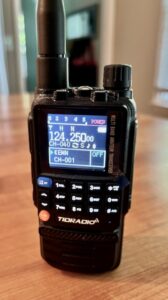
TIDRadio TD-H3
Seems like there is no shortage of new Amateur Band and GMRS radios out there for sale. Today we’ll take a look at the TIDRadio TD-H3. TIDRadio has been around since 2013, however, this is the first one of their radios I have owned. They are available on Amazon for about $32. When you see what this radio can do you will recognize that $32 is a STEAL.
This radio follows a trend that I, and many others have noticed. The consumer wants a radio that can do it all despite any FCC rules or regulations stating otherwise. The buying public seems to want radios that can be unlocked to do much more than they are certified to do.
And that is pretty much what we have here with the TIDRadio TD-H3. It should be noted that if you buy the Amateur TD-H3 (HAM) it doesn’t break any rules. When you buy the TD-H3 (GMRS) version it is also set up for GMRS rules and regs.
It is when the owner unlocks the radio is where the fun begins. Again, it seems like this is what radio customers want these days.
Continue reading

My new friends at ACMER recently sent me their P1 S Pro to review and they promptly followed that up by sending me an ACMER P1 10 watt laser engraver, an M2 Rotary Roller, and an R10 Enclosure.
I’ll just be featuring the ACMER P110 watt laser in this blog though and will cover the other items in a subsequent entry.
The P1 laser checks in at $339 on their website with the 10 watt laser head.
Continue reading
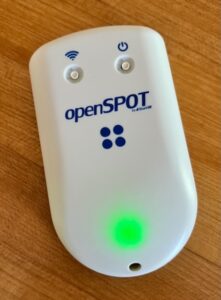
SharkRF Openspot 4 Pro
I bought a SharkRF Openspot 1 in around 2018. So I have been a long time user of SharkRF gear. I absolutely, positively did NOT need another DMR hotspot but I sprung for the SharkRF Openspot 4 Pro anyway.
Boy I sure am I glad that I did.
I am no hotspot rookie and currently have 4 Raspberry Pi with various MMDVM boards in rotation here at Casa John’s Tech Blog. I run Pi-Star and WPSD OS’s. And have toyed with various other OS’s over the years.
There are strengths and weaknesses in all these DMR hotspots. One weakness in the Pi-Star world is that it needs to be shut down elegantly. When you have a hotspot plugged in a USB port in your truck which uses your cell phone for internet it is kind of hard (and very inconvenient) to find the IP address, open a web page on your phone and shut it down. Sooner rather than later you are going to corrupt the SD card on the Raspberry Pi if you just kill the power. In fact I have done this a few times.
The SharkRF Openspot 4 Pro caught my eye because it is battery powered.
And that is all I really wanted for my mobile hotspot. Something I wouldn’t kill from uncommanded shut downs.
What I got was so much more than I expected. Read on.
Continue reading
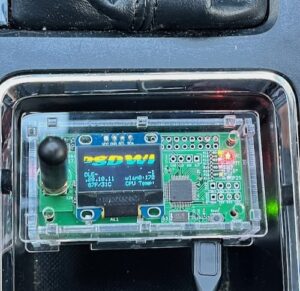
DMR Hotspot
So you have decided to take the leap into Digital Mobile Radio (DMR). DMR uses the internet as the backbone for carrying communications. Adding an MMDVM board to a Raspberry Pi is one common way to create a hotspot.
To get to that backbone you need to enter the internet either through a DMR Repeater or through a DMR Hotspot.
A hotspot is just a gateway to the internet and your radio talks to the hotspot and then your transmission is carried through the net to someone else’s repeater or hotspot.
I’d be remiss in not pointing out that so far no radio companies have really jumped in this market. You would think that the big dog radio manufacturers that sell DMR radios would also produce DMR Hotspots, but they really don’t.
It is mostly amateur operators who design and produce MMDVM boards and sell them to the public. You then roll your own. There are a couple of exceptions here as Bridgecom Systems sells pre-configured DMR Hotspots. Also, a company called Shark RF sells a hotspot called OpenSpot. Both are kind of pricey.
Continue reading
The FCC started getting serious about the importation of unlocked ham radios sometime around 2019 or so. An unlocked radio is one that transmits on frequencies not intended for the type of radio that it is. For example, a GMRS radio should not be able to transmit on amateur radio frequencies and vice versa. Some folks also refer to this as jailbreaking although that term is more synonymous with cellular phones or game consoles.
The rules regarding the importation and sale of such radios in the US is pretty clear, especially regarding any Family Radio Services such as FRS, GMRS, and MURS.
Continue reading
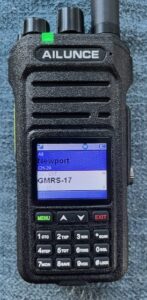
Ailunce HA1G
Ailunce (made by Retevis?) has recently released the Retevis Ailunce HA1G GMRS radio and it sure looks like a contender. There is no shortage of GMRS hand held radios out there. Many of those offerings are inexpensive, as well. So you need some standout features to compete in this marketplace. For me the stand out features are its Ingress Protection level (IP67) which is a waterproof rating. Essentially, that means you can get caught in a wicked rainstorm while hiking and not worry about your comms. The Ailunce HA1G also has an interesting screen layout and menu system.
Another huge plus is that it is ready to roll right out of the box. All 22 GMRS channels are programmed in along with the 8 repeater channels. Programming from the radio itself is fairly easy and most users wouldn’t need to connect to the Customer Programming Software (CPS).
Before you purchase get the FCC ID number of the radio and run it through the FCCID website. Here is the data for the HA1G. All of the technical data and testing reports are available to download and view in addition to product manuals, photos, etc.
DO YOUR HOMEWORK FIRST BEFORE SPENDING YOUR MONEY.
Continue reading
This is kind of a trick question. Technically, there are radios capable of doing this. And you can buy these radios today. The inherent problem though is that these radios violate the United States Code of Federal Regulations (CFR) Title 47 and FCC Rules and Regulations for Amateur Radio and General Mobile Radio Service (GMRS) radios to include Family Radio Service (FRS) and Multi Use Radio Service (MURS).
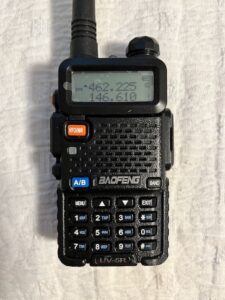
Baofeng UV-5R Pre-2021
Actually, a few years ago there were radios being imported into the United States that were capable of VHF/UHF, FRS, GMRS, and MURS.
If you bought the venerable Baofeng UV-5R prior to 2021 you had all these capabilities. In 2021 the FCC started disallowing the importation of radios that didn’t meet newly written regulations.
Subsequently, I bought several of these things when I first got my FCC License and still have them all. The UV-5R’s prior to 2021 were the magic radios that did it all.
Continue reading
I think there may be a perception by non-radio users that us Hams simply buy radios and just push the microphone or Push To Talk (PTT) button. If only it were that simple. In this day and age most radios come with a hunk of software called Customer Programming Software or CPS. With that CPS software, the user must create something called a Codeplug. The Codeplug must then be uploaded to the radio. This usually entails having a programming cable. The programming cable almost never comes with the radio and must be purchased separately. I swear that I will never understand this.
The first time you look at a CPS program it is just a bit intimidating. So many fields to populated with information you may or may not know about as a new ham.

And I’m mostly talking about analogue radios here. When I bought my first DMR radio, a Connect Systems CS800, I had no earthly idea what to do next. I started looking a Codeplug to download. The problem with that is your Codeplug is pretty specific to your local area. Subsequently, It should be programmed for your local amateur radio repeaters. For digital radios it will also include your favorite talk groups.
Continue reading